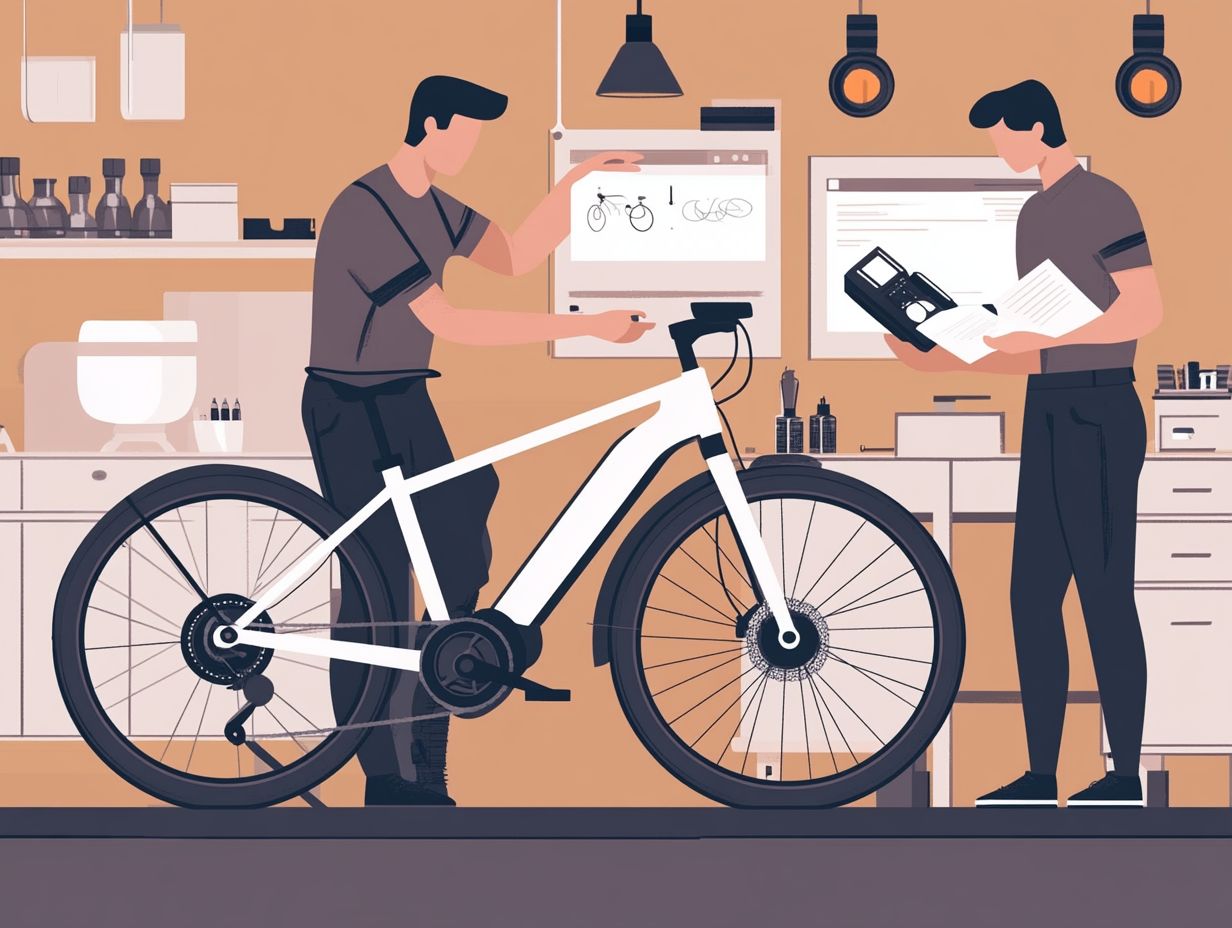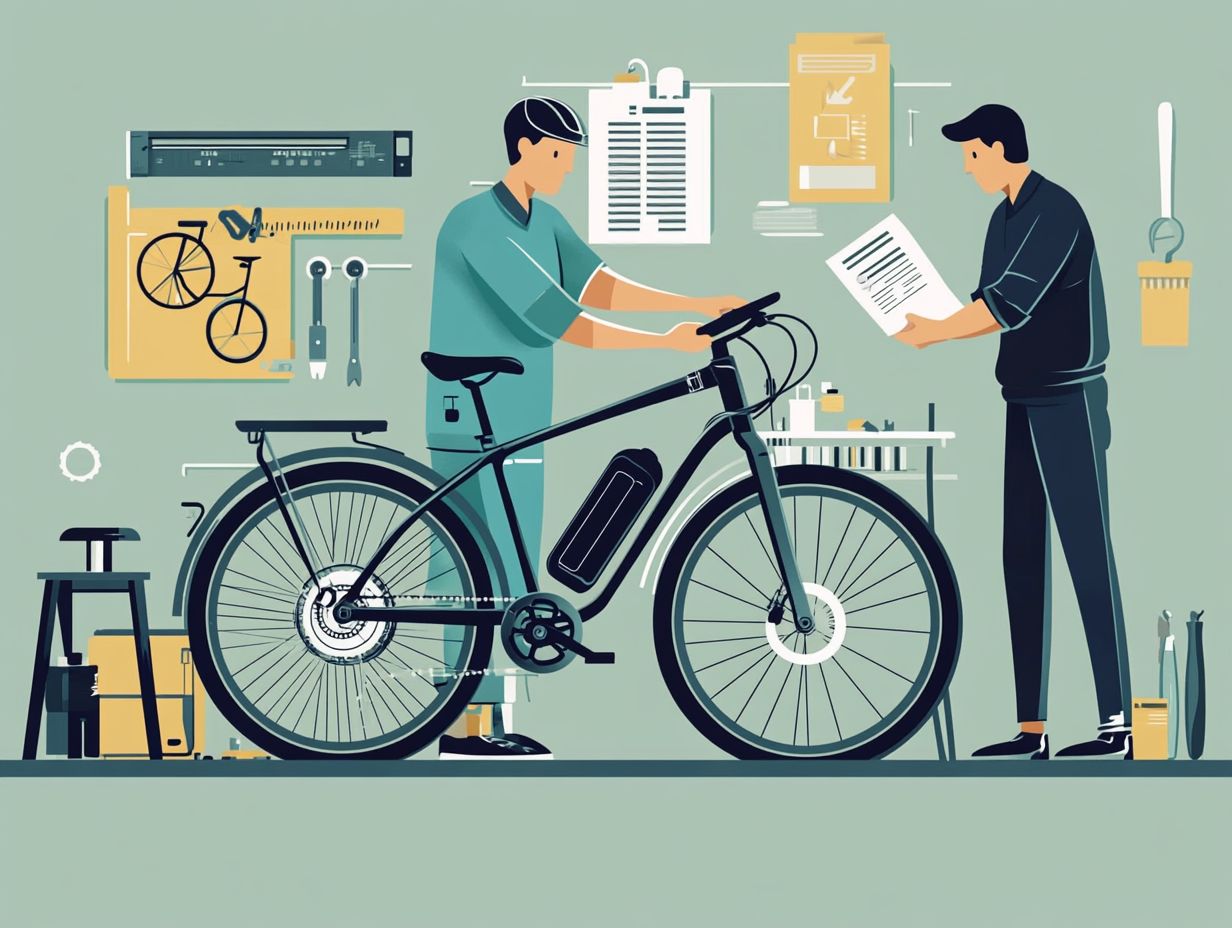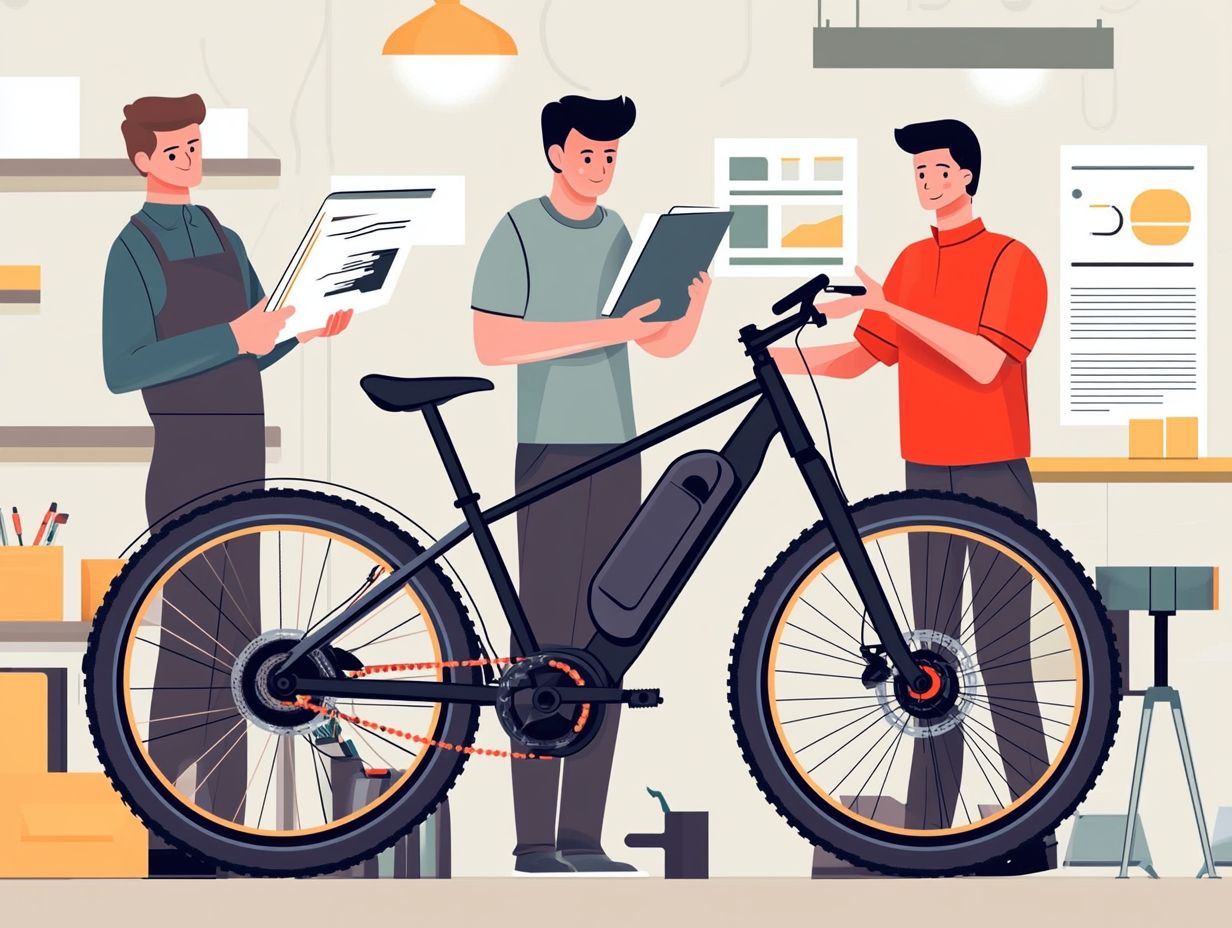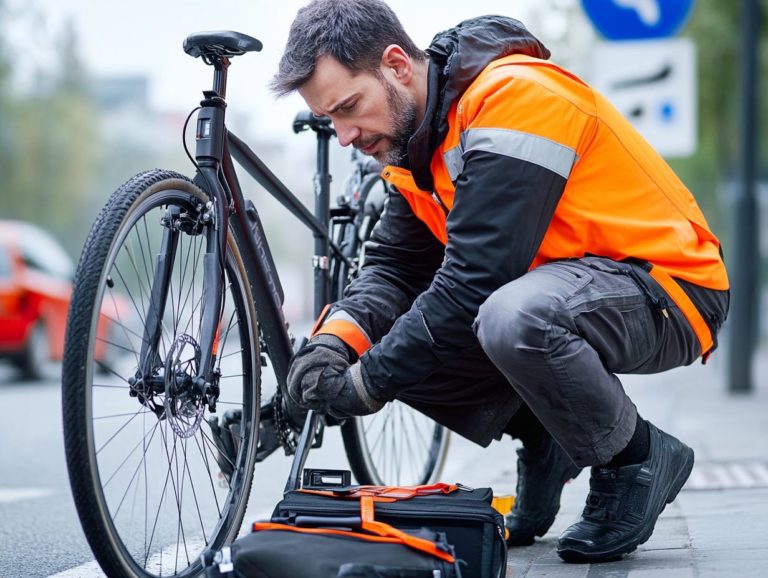The Most Common Electric Bicycle Problems Explained
Electric bicycles present an exhilarating and eco-friendly means to explore your surroundings, though they can occasionally encounter some challenges. You might also face common issues such as electrical problems, wiring issues, mechanical issues, battery charging troubles, and brake failures. This guide is here to help you troubleshoot and resolve these problems, ensuring your ride remains smooth and enjoyable.
Whether you’re a seasoned e-bike enthusiast or just starting your journey, this information will empower you to keep your wheels turning with confidence and ease.
Contents
- Key Takeaways:
- Electrical Problems
- Understanding Mechanical Issues
- Battery Problems
- Brake Problems
- Tire Problems
- Frequently Asked Questions
- What are the most common electric bicycle problems?
- How can I fix a dead battery on my electric bicycle?
- What should I do if my electric bicycle’s motor stops working?
- How can I prevent electrical problems on my electric bicycle?
- What should I do if my electric bicycle’s brakes are not working properly?
- How can I fix a flat tire on my electric bicycle?
Key Takeaways:

- Proper maintenance and regular check-ups can help prevent common electric bicycle problems.
- Electrical issues can be identified and fixed by checking the battery, wiring, and connections.
- Mechanical problems can be resolved by inspecting and adjusting the brakes, gears, and chain regularly.
Overview of Common Issues
Electric bikes, or e-bikes, have surged in popularity, thanks to their efficiency and eco-friendliness. However, you may encounter some common issues that could dampen your riding experience. Understanding these challenges and having a solid troubleshooting guide at your disposal is essential for a seamless ride. From battery charging hiccups to pedal assist failures, this overview dives into the most frequent complications you might face as an electric bicycle owner, offering insights for effective DIY troubleshooting.
As an electric bike user, you might find yourself facing various issues that can interrupt your riding enjoyment. Common electrical problems include:
- Faulty wiring
- Malfunctioning displays
These headaches can impact power delivery or obscure crucial metrics like battery life.
Mechanical challenges could arise from:
- Loose components
- Misaligned brakes
Such obstacles can compromise both safety and performance.
Battery-related dilemmas, such as:
- Inconsistent charging
- Diminished capacity
often plague e-bike owners, leading to a frustratingly reduced range. Braking concerns, particularly with squeaky or ineffective brakes, can further create unsafe riding conditions. Addressing these categories not only extends the longevity of your bike but also enriches your overall cycling experience.
Electrical Problems
Electrical problems in electric bikes rank among the most prevalent challenges you may encounter, significantly impacting both performance and usability. These problems can come from bad wiring, controller issues, or poor battery management. Grasping the implications of each factor is essential for maintaining your e-bike’s efficiency.
If you find yourself facing throttle assist or pedal assist system failures, your rides could quickly become less enjoyable and more taxing. You must identify and fix these electrical problems quickly to enjoy your ride!
Identifying and Troubleshooting Electrical Issues
Identifying electrical issues in your electric bike requires a systematic approach. Using tools like a voltage tester makes diagnosing problems easier.
Common issues can often stem from the controller, wiring, or battery components. Knowing how to troubleshoot these can save you both time and money.
Start by checking the connections and ensuring your battery is fully charged. If your bike isn t responding to throttle or pedal assist, it may indicate a deeper issue that calls for a thorough inspection of the wiring and the settings that control your bike’s power and speed.
With that voltage tester ready, examine the battery terminals for proper voltage readings. Low voltage is your red flag time to recharge or consider a replacement. Next, give the controller a good once-over, making sure all wires are securely connected and free from corrosion.
Testing the voltage output from the controller to the motor will help you determine whether the culprit lies within these components. Interpreting those readings accurately is crucial; a significant drop in voltage typically points to faulty parts.
If issues persist despite your efforts, it might be wise to consult a professional technician who specializes in electric bike repairs.
Understanding Mechanical Issues

Mechanical problems in e-bikes can greatly influence your overall riding experience. It s crucial to stay informed about potential issues related to your bike frame and brake functionality.
Like any bicycle, electric bikes demand regular maintenance and repairs to guarantee smooth operation and longevity.
Common mechanical challenges include:
- Misalignment of the bike frame
- Brakes not functioning properly
- Worn-out brake pads
By understanding these issues, you can tackle them head-on. This ensures a smooth, safe ride every time you hop on your electric bike!
Addressing Common Mechanical Problems
Addressing common mechanical issues in electric bicycles often starts with routine inspections and proper maintenance repairs. Focus on key areas like the bike frame, brake pads, and sensors, which are essential for ensuring both safety and performance.
Regularly checking brake functionality and replacing worn brake pads can prevent accidents and significantly enhance your riding experience. Inspect the bike frame for any damage to maintain stability and control.
To ensure optimal performance, keep a close eye on your electric bike’s wiring and battery connections. A thorough check can help you spot potential problems such as frayed wires or loose connectors that could hinder functionality.
Keeping components clean and lubricated, especially the chain and gears, greatly reduces wear and tear, extending your bike’s lifespan. Checking the alignment of the wheels can prevent uneven tire wear while enhancing the overall riding experience.
Keeping up with your bike s maintenance boosts its durability and gives you the confidence to ride boldly!
Battery Problems
Battery issues frequently take center stage for electric bike users, as they significantly influence the bike’s performance and usability. You might encounter common battery challenges such as improper charging, inadequate battery management, and the inevitable decline that comes with time.
Grasping how to effectively troubleshoot these battery-related concerns is essential for you as an e-bike owner. Safeguarding the functionality and efficiency of your electric bicycle is paramount.
By adhering to proper charging practices and being vigilant about the signs of battery failure, you can extend your battery’s lifespan and elevate your overall riding experience.
Stay vigilant and proactive about your battery. This way, you ll ensure a smooth ride for many journeys to come!
Diagnosing and Fixing Battery Issues
Diagnosing battery issues in your electric bike requires a systematic approach. Start with a thorough check of the charger to ensure it meets the necessary specifications. When troubleshooting charging problems, using a voltage tester can provide valuable insights into the battery’s health and charging capabilities.
Recognizing signs of a faulty battery, such as inconsistent performance or an inability to charge, is crucial for timely intervention. Address the issue before it escalates.
- Carefully inspect the charger for any visible damage, like frayed cords or bent prongs, and ensure it is properly connected.
- Next, plug the charger into a power source and use the tester to measure the voltage output; it should align with the specifications listed.
- If the charger seems functional, shift your focus to the battery itself.
- Disconnect it and check for any corrosion on the terminals, as this can disrupt the connection.
- Using the voltage tester again, measure the battery voltage to evaluate its condition and determine whether it’s holding a charge.
This comprehensive evaluation will allow you to pinpoint the root of the problem, leading to an effective resolution.
Brake Problems

Brake problems are paramount to the safety and functionality of electric bikes. Ineffective brakes can lead to accidents and potential injuries. Stay vigilant about the condition of your brakes, including the brake sensors and pads, as they significantly impact overall performance.
Regular maintenance keeps your bike safe and fun to ride! Identifying and resolving any brake issues ensures that your electric bicycle operates both safely and reliably on the road. Additionally, understanding how to troubleshoot common battery issues is crucial for optimal performance. By learning how to assess and repair common brake problems, you can enjoy a smoother, safer riding experience. For more detailed guidance, check out troubleshooting electric bicycle battery issues.
How to Handle Brake Malfunctions
Handling brake malfunctions in your electric bike starts with a solid understanding of key components involved, such as brake pads and brake sensors, which help monitor braking performance. Regular inspections and timely maintenance can prevent minor issues from becoming major headaches.
When you encounter a malfunction, begin with a visual inspection of the brake pads for any signs of wear and tear. Check the brake sensors to confirm they’re functioning correctly.
Next, ensure that the brake lines are intact and free of leaks. Any compromise here can significantly diminish your braking power. Cleaning the brake components is also important, as accumulated dirt and debris can hinder their performance.
If you discover that the pads are heavily worn, replace them right away to keep yourself safe!
When inspecting the sensors, make sure they are aligned correctly and not obstructed. Consult your owner’s manual for specific repair guidelines tailored to your electric bike model. This will streamline the repair process and enhance the overall reliability of your ride.
Tire Problems
Tire problems frequently plague electric bike riders, with flat tires being a common concern that can abruptly interrupt your journey. Prioritize proper tire maintenance and stay vigilant about potential tire issues to ensure a smooth and enjoyable ride on your electric bicycle.
By regularly checking tire pressure, tread wear, and overall condition, you can identify problems early on. This safeguards against more significant complications in the future. Mastering the art of addressing tire issues not only enhances your safety but also significantly improves the overall performance of your e-bike.
Dealing with Flat Tires and Other Tire Issues
Dealing with flat tires and other issues on your electric bicycle demands a proactive approach to maintenance and repair.
Routine checks are essential. Monitor tire pressure between 30-50 psi as per your bike’s specifications. Assess tread wear and inspect for cuts or foreign objects lodged in the rubber.
Understanding how to utilize a tire lever a tool to help remove tires and apply patches correctly can significantly enhance the quality of your rides.
Be alert for signs of uneven wear, which may hint at misalignment, or bulges that could indicate internal damage. Prioritizing these inspections and repairs ensures a safer, smoother ride for your electric bike tires.
Frequently Asked Questions

What are the most common electric bicycle problems?
The most common electric bicycle problems include battery issues, motor malfunctions, faulty wiring, brake problems, and tire punctures.
How can I fix a dead battery on my electric bicycle?
To fix a dead battery, you can try battery charging it fully or replacing it with a new one. Check and clean the battery terminals and connections to ensure proper connection.
What should I do if my electric bicycle’s motor stops working?
If your electric bicycle’s motor stops working, first check the battery and wiring connections. If those are not the issue, it may be a problem with the motor itself, requiring a professional for repair.
How can I prevent electrical problems on my electric bicycle?
To prevent electrical problems, regularly check and maintain the battery management, wiring, and connections. Avoid exposing your electric bicycle to extreme weather conditions and ensure you use the appropriate charger for your battery.
What should I do if my electric bicycle’s brakes are not working properly?
If your electric bicycle‘s brakes are not working properly, first check if the brake pads need to be replaced or adjusted. If the issue persists, it may be a problem with the brake cables or levers, and a mechanic may need to take a look.
How can I fix a flat tire on my electric bicycle?
To fix a flat tire on your electric bicycle, follow the same steps as you would for a regular bicycle. Use puncture-resistant tires and carry a spare tube or patch kit for emergencies.






